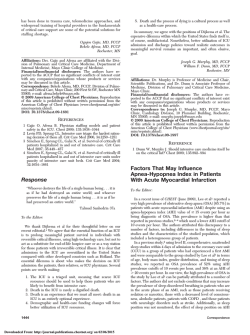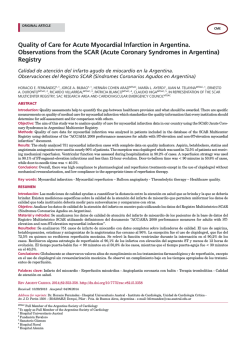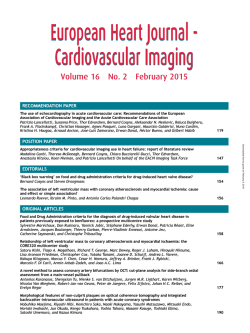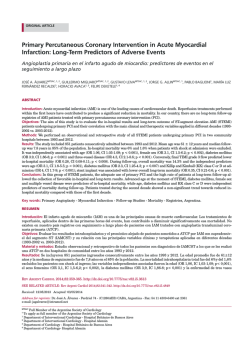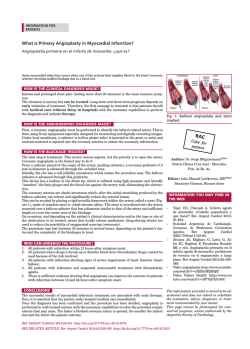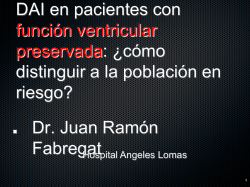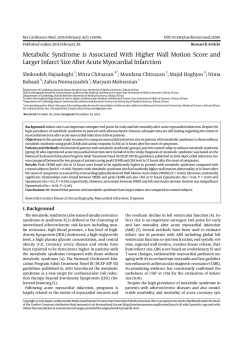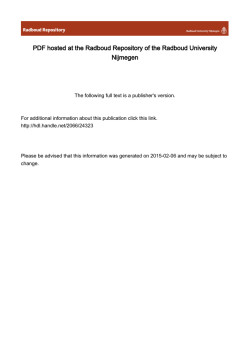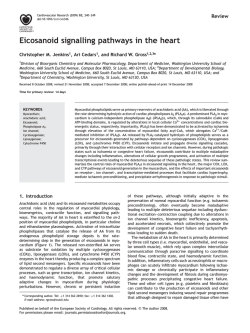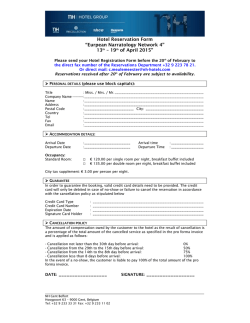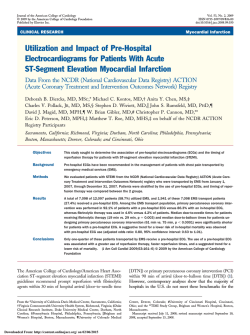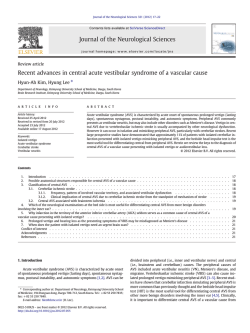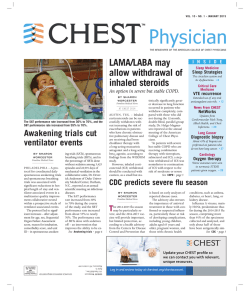
CORONARY CARE UNIT AMONG MINORITY AND
PAIN AND ARRI VAL TO THE CORONARY CARE UNIT AMONG MINORITY AND DISADVANTAGED PATIENTS Jalal K. Ghali, MD, Richard S. Cooper, MD, Imad Kowatly, MD, and Youlian Liao, MD Chicago and Maywood, Illinois Prehospital delay is an important cause of out-of-hospital coronary mortality. To determine the effects of decision time delay in a patient population comprised mainly of blacks and the underprivileged, 74 consecutive patients with acute chest pain necessitating admission to the coronary care unit in a large urban hospital were studied. Delay time from onset of chest pain to the decision to seek medical care was markedly prolonged in patients with myocardial infarction (n = 24; mean time: 11.3 ±18 hours) as well as in patients with chest pain who did not develop myocardial infarction (n = 50; mean time: 20.5 ± 26 hours). In addition, transfer time from the emergency room to the coronary care unit was likewise unduly long (mean time: 4 ±3.8 and 4.1 ±6 hours for patients with and without myocardial infarction, respectively). This study documents a significant delay in the decision time among patients with low socioeconomic status, mostly inner-city blacks, and in the transfer time from emergency room to the critical care unit in a large public hospital. These findings From the Section of Clinical Epidemiology, Division of Cardiology, Cook County Hospital, Chicago, and the Department of Preventive Medicine and Epidemiology, Loyola University Stritch School of Medicine, Maywood, Illinois. Requests for reprints should be addressed to Dr Jalal K. Ghali, Dept of Preventive Medicine and Epidemiology, Loyola University Stritch School of Medicine, 2160 S First Ave, Maywood, IL 60153. 180 must be taken into consideration when planning strategies to improve the health-care delivery system to blacks and the underprivileged and further lend support to the practice of initiating thrombolytic therapy in the emergency room. (J Nat! Med Assoc. 1993;85:180184.) Key words * chest pain * prehospital delay * blacks In the current era of thrombolytic therapy, the speedy arrival of patients complaining of chest pain to acute health-care facilities is of critical importance.",2 Numerous studies''19 have addressed the issue of prehospital delay, and several have concluded that the time delay between the onset of chest pain and the decision to seek medical care is largely the cause of late arrival to hospitals. 1-13 However, these studies have examined the response of patients from populations composed mainly or exclusively of nonblacks. Our previous study reported'4 a significant time delay between the onset of chest pain and the arrival to the emergency room among blacks with acute myocardial infarction. The purpose of the present study was to investigate the separate components of prehospital delay in a consecutive group of patients complaining of chest pain who were admitted to the coronary care unit in a large city hospital serving blacks and other underprivileged groups. METHODS Patients admitted to the coronary care unit of Cook JOURNAL OF THE NATIONAL MEDICAL ASSOCIATION, VOL. 85, NO. 3 ONSET OF CHEST PAIN County Hospital from December 1988 through April 1989 were included in the study population if they met the following criteria: acute chest pain thought to be ischemic in origin, the occurrence of chest pain at a nonhealth-care facility, or the ability of the patient or his or her relative or friend to recall the time of onset of chest pain. All patients transferred from other hospitals were excluded, as were patients providing implausible time estimates (eg, >1 week). A total of 74 patients were included in the study. A questionnaire was administered to all patients and in some instances, to a relative or friend. Patients were interviewed by one of the investigators (IK) in the coronary care unit as early as feasible in the hospital course, within 24 hours of admission to the coronary unit. Delay times were defined as follows: * patient decision delay-time from onset of symptoms to a definite decision to seek medical help, * transportation and unaccounted delay-time from decision to seek medical help to the arrival at the emergency room, * delay from onset of chest pain to arrival to the emergency room-the sum of patient decision delay and transportation and unaccounted delay, * emergency room delay-time from arrival in the emergency room to arrival in the coronary care unit, and * total delay-time from onset of chest pain to arrival in the coronary care unit. The diagnosis of myocardial infarction was made when a clinical history of chest pain typical of acute myocardial infarction or the development of new Q waves or evolving ST-T changes was accompanied by an elevation of the CPK-MB fraction with an appropriate temporal pattern. Because various delay times measured were not normally distributed, both mean and median values are presented. Student's t test was used to examine differences in the group means. Analyses were performed separately in the total sample and in blacks alone (who constituted 81% of the cohort). No important differences were demonstrated, and therefore the findings obtained in all patients are presented. RESULTS Tables 1 and 2 compare patient characteristics and length of decision time between patients who had myocardial infarction and those who had chest pain but did not develop myocardial infarction. Patients with myocardial infarction were older and a higher percentage were married (P<.05). Other differences, which did not reach statistical significance, included a higher JOURNAL OF THE NATIONAL MEDICAL ASSOCIATION, VOL. 85, NO. 3 TABLE 1. PATIENT CHARACTERISTICS Myocardial Chest Age (years) Males Blacks Married Education >9 years Employed Prior myocardial infarction Diabetes Hypertension Family history of heart disease lnfarction* Paint 63.5±14 70.8% 83.3% 73.9% 55.8±11 47.1% 26.1% 36.4% 33.3% 87.5% 41.7% 52% 80% 46% 66.7% 33.3% 42% 34% 76% 56.3% *n =24. tn =50. number of females, less than 9 years of education, and a family history of heart disease in patients with chest pain but no myocardial infarction. The decision time as well as the time delay from the onset of chest pain to arrival at the emergency room was prolonged in the group with myocardial infarction (median time: 3 and 4.6 hours, respectively) and in those without myocardial infarction (median time: 9.5 and 10.4 hours, respectively). The influence of various factors on the patient's decision time were examined. The variables included the following: age, sex, education, marital status, employment, family history of heart disease, prior myocardial infarction, diabetes mellitus, and having been exposed to a cardiac procedure (including echocardiogram, exercise test, and cardiac catheterization). In the group with no myocardial infarction, a history of prior myocardial infarction was significantly related to shortened decision time (mean time: 12.5 ± 16.5 hours versus 26.3 ± 30.6 hours; median time: 5.5 hours versus 12 hours). Similar findings emerged in patients exposed to cardiac procedures compared with those who did not have prior exposure to cardiac procedures (mean time: 12.1 ± 16 hours versus 33.4 ± 33.4 hours; median time: 5.8 hours versus 23 hours). None of the above mentioned variables were found to influence decision time in patients with acute myocardial infarction, although the sample size was small. It should be noted that in the presence of small sample size, the differences of potentially influential variables may not reach statistical significance. The transfer time from the emergency room to the critical care unit was surprisingly longer in patients with myocardial infarction (median time: 3 hours) than in 181 ONSET OF CHEST PAIN TABLE 2. LENGTH OF TIME IN HOURS BETWEEN ONSET OF SYMPTOMS AND DECISION TO SEEK MEDICAL ATTENTION Chest Pain Myocardial Infarction Median Mean Mean Median 9.5 20.5 ± 26.3 3 11.3±18 Total decision time 21.4 ± 26.3 10.4 4.6 12.3±18 Time from chest pain onset to arrival at emergency room 2 4.1 ±6 3 4±3.8 Time from arrival at emergency room to admission in critical care unit TABLE 3. LENGTH OF PREHOSPITAL DELAY IN PREVIOUS STUDIES Median Mean % No. of (Min) Length of Delay Year Patients Black Condition (Min) Authors 180 Within 14 hrs of admission Ml 1968-69 134 Moss and Goldstein3 760 Ml 48 1970 Tjoe and Luria5 558 27 CP -1 hr: 40%; >3 hrs: 69% Ml, CP 1971 137 Erhardt et al8 -1 hr: 70%; -4 hrs: 90% Ml Simon et al6 1972 160 Ml 269 60 Gilchrist7 1973 50 Ml 73 60 1974 Gillum et a118 Ml 312 Ml developed >6 hrs of 30 60 Shroeder et al9 1975 admission 247 Q wave Ml Ml 59 49 447 Non-Q wave Ml Ml 260 12 240 Noncardiac pain CP 93 18 328 Ml ruled out CP 90 102 159 Ml 15 1978-80 110 Pressely et al10 Ml 60 1987 37 Leitch et a11 60 CP 63 Ml 83 180 678 -1 hr: 20%; -4 hrs: 63% Current study 1988-89 24 1230 <1 hr: 10%; -4 hrs: 32% CP 50 80 570 Abbreviations: Ml= myocardial infarction and CP = chest pain without myocardial infarction. patients without myocardial infarction (median time: 2 hours). It is possible that the transfer was delayed because of a chronic shortage of acute care beds. On the other hand, patients who presented with chest pain without evidence of acute myocardial infarction were transferred to the step-down section of the critical care unit without the same delay encountered in securing beds. Moreover, none of the patients in this study received thrombolytic therapy prior to their arrival in the critical care unit. DISCUSSION The findings of this study confirm the significant time delay encountered in our study population in the decision to seek medical attention after experiencing chest pain. Although several studies have documented that decision time accounts for most of prehospital delay,141 its magnitude in our patients is alarming. The median 182 decision time in this study is at least three times longer than the values reported in previous series (Table 3). It is tempting to implicate the lower socioeconomic status of our patients to explain the prolonged delay observed in this study.'5'19 However, previous studies that examined this question did not find this variable to be a factor that contributed to excessive delay. In the study by Hackett and Cassem,4 there was a trend for a longer decision time in the low socioeconomic group (the mean delay was 5.4 hours longer than those with a higher socioeconomic status). Earlier studies may not be applicable at the present time, however. With the significant expansion of public awareness of coronary disease, the implications of warning signs like chest pain could have impacted more on persons of higher socioeconomic status. Thus, the question of the impact of the socioeconomic status on decision time and prehospital delay is still open. JOURNAL OF THE NATIONAL MEDICAL ASSOCIATION, VOL. 85, NO. 3 ONSET OF CHEST PAIN The positive influence of prior myocardial infarction on subsequent decision time is at variance with previous reports.3-9'18 A possible explanation is that the previous studies were undertaken in the late 1960s or early 1970s, and it may well be that in the ensuing decade, patients who suffered myocardial infarction received more education about the importance of early medical attention. Similarly, the finding that prior exposure to cardiac procedures (including echocardiogram, treadmill, or cardiac catheterization) was associated with a significantly shorter decision time is interesting. This exposure may have resulted in these patients being more informed about the urgency of obtaining immediate care for potential heart attack symptoms than the general population; however, these patients may have already been more health conscious, which may have prompted the performance of the cardiac procedures. The latter explanation seems more, likely and is supported by a 2:1 ratio of prior cardiac procedures in patients with chest pain and no myocardial infarction compared with the group with myocardial infarction. We noted a shortening in the length of delay from the onset of chest pain to the patient's arrival at the emergency room (median time: 4.6 hours) compared with our previous study (median time: 6.4 hours). During a similar time frame (1983 to 1988), Maynard et a120 reported a significant increase in the proportion of patients arriving within 1 hour of symptom onset in the Western Washington Thrombolytic Therapy Trials. They proposed that a concerted media campaign directed by the American Heart Association of Washington was the most likely explanation. No organized public education campaign,21'22 however, was instituted in the Chicago area during that period, and such an effort has not always proven to be successful.23 Moreover, long-term effects following such a campaign have never been evaluated. Thus, although it is possible that there was an increased awareness of the general public of the need for earlier response to symptoms suggestive of heart attack, there is no evidence to substantiate this hypothesis. If reducing the delay in response to the symptoms of acute health crisis such as chest pain calls less for a knowledge-based strategy and more for a behaviorally and affective-oriented one, then a better understanding of the processes of symptom interpretation, denial, and coping strategies is in order. In addition, the social situations within which individuals evaluate and construct such strategies for coping with acute symptoms such as chest pain should be explored further.' 524 JOURNAL OF THE NATIONAL MEDICAL ASSOCIATION, VOL. 85, NO. 3 Anothe.r finding from this study that deserves a comment is the significant delay encountered in the transfer of patients from the emergency room to the critical care unit (median time: 3 and 2 hours for the groups with and without acute myocardial infarction, respectively). Such a delay gives unequivocal support to the increasing practice of initiating thrombolytic therapy in the emergency department.25'26 CONCLUSION This study documents a significant delay in the decision time among patients with low socioeconomic status, mostly inner-city blacks. This finding must be taken into consideration when planning ways to improve the health-care delivery system to blacks and the underprivileged. Acknowledgment The authors thank Kathleen Regalado for her secretarial assistance. Literature Cited 1. Gruppo Italiano per lo Studio della striptochinasi nell' infarcto miocardico (GISSI): effectiveness of intravenous thrombolytic treatment in acute myocardial infarction. Lancet. 1986;1 :397-402. 2. ISIS-2 Collaborative Group. Randomized trial of intravenous streptokinase, oral aspirin, both, or neither among 17 187 cases of suspected acute myocardial infarction: ISIS-2. Lancet. 1 988;2:349-360. 3. Moss AJ, Goldstein S. The pre-hospital phase of acute myocardial infarction. Circulation. 1970; 737-742. 4. Hackett TP, Cassem NH. Factors contributing to delay in responding to the signs and symptoms of acute myocardial infarction. Am J Cardiol. 1969;24:651-658. 5. Tjoe SL, Luria MH. Delays in reaching the cardiac care unit: an analysis. Chest. 1972;61:617-621. 6. Simon AB, Feileib M, Thompson HK. Components of delay in the pre-hospital phase of acute myocardial infarction. Am J Cardiol. 1972;30:476-482. 7. Gilchrist IC. Patient delay before treatment of myocardial infarction. Br Med J. 1 973;1 :535-537. 8. Erhardt LR, Sjogren V, Sawe V, Theorell T. Pre-hospital phase of patients admitted to a coronary care unit. Acta Medical Scandinavica. 1974;196:41-46. 9. Schroeder JS, Lamb IH, Hu M. The pre-hospital course of patients with chest pain. Analysis of the prodromal, symptomatic, decision making, transportation and emergency room periods. Am J Cardiol. 1978;64:742-748. 10. Pressley JC, Wilson BH, Severance HW Jr, Raney MP, McKinnis RA, Smith MW, et al. Basic emergency medical care of patients with acute myocardial infarction: initial pre-hospital characteristics and in-hospital complications. Journal of the American College of Cardiology. 1984;4:487-492. 11. Leitch JW, Birbara T, Freedman B, Wilcox I, Harris PJ. Factors influencing the time from onset of chest pain to arrival at hospital. Med J Aust. 1 989;150:6-10. 12. Moss AJ, Wynar B, Goldstein S. Delay in hospitalization 183 ONSET OF CHEST PAIN during the acute coronary period. Am J Cardiol. 1969;24:659665. 13. Zmyslinski RW, Lackland DT, Keil JE, Higgins JE. Increased fatality and difficult diagnosis of in-hospital acute myocardial infarction: comparison to lower mortality and more easily recognized pre-hospital infarction. Am Heart J. time of hospital arrival in acute myocardial infarction. Am J Cardiol. 1986;58:203-209. 20. Maynard C, Althouse R, Olsufka M, Ritchie JL, Davis KB, Kennedy JW. Early versus late hospital arrival for acute myocardial infarction in the Western Washington Thrombolytic Therapy Trials. Am J Cardiol. 1989;63:1296-1300. 21. Herlitz J, Hartford M, Blohm M, Bjorn KW, Ekstrom L, Risenfors M, et al. Effect of a media campaign on delay times and ambulance use in suspected acute myocardial infarction. Am J Cardiol. 1989;64:90-93. 22. Mitic WR, Perkins J. The effect of a media campaign on heart attack delay and decision times. Can J Public Health. 1984;75:41 4-41 8. 23. Hu MT, Eisenberg MS, Litwin PE, Schaeffer SM, Damon SK. Delay between onset of chest pain and seeking medical care: the effect of public education. Ann Emerg Med. 1989;18:727-731. 24. Alonzo AA. Acute illness behavior: a conceptual exploration and specification. Soc Sci Med. 1980;1 4A:515-526. 25. Smith M, Eisenberg MS. Thrombolytic therapy for myocardial infarction: pivotal role for emergency medicine. Ann Emerg Med. 1987;1 6:592-593. 26. Ornato JP. Role of the emergency department in decreasing the time to thrombolytic therapy in acute myocardial infarction. Clin Cardiol. 1 990;1 3:48-52. 1981;101:586-591. 14. Cooper R, Simmon B, Castener A, Prasad R, Franklin C, Ferlinz J. Survival rates and pre-hospital delay during myocardial infarction among black persons. Am J Cardiol. 1986;57:208-21 1. 15. Wielgosz ATJ, Nolan RP, Earp JA, Biro E, Wielgosz MB. Reasons for patients' delay in response to symptoms of acute myocardial infarction. Can Med Assoc J. 1988;1 39:853-857. 16. Rawles JM, Haites NE. Patient and general practitioner delays in acute myocardial infarction. Br Med J. 1981;282:16771679. 17. Sharkey SW, Brunette DD, Ruiz E, Hession WT, Wysham DG, Goldenberg IF, et al. An analysis of time delays preceding thrombolysis for acute myocardial infarction. JAMA. 1989;262:3171-3174. 18. Gillum RF, Feinleib M, Margolis JR, Fabsitz RR, Brasch RC. Delay in the pre-hospital phase of acute myocardial infarction. Arch Intern Med. 1976;1 36:649-654. 19. Turi ZG, Stone PH, Mulkz JE, Parker C, Rude RE, Raabe DE, et al. Implications for acute intervention related to ..................... 11-1 ................................... .................................. .............................................................................................................. .......................................... .................. ... .. .%. -X ...... ........................... .............. X ... .::::V .. ....... ............ ....................... %... .............................. ....................................... .................... ... ..................... .............................................. Xt .............. IR ..... .. .. ..... ....................... ............................ .... X. % .. A. ................... ....... ........................ ...... Or"m X .................. ..................... .................................. ................. dd. X.. .............. :: F:V .................................................... %.............................. ........ ................ ........... ................. .................................... X.: X.: .................................... ...... ........... ...... ...................... .......................... .............................. .. 44 ............. .:-, % ......... ........... ................ ................. .............................. ................... ........... .. :: ............ .: .................. V.....% ............................................... -.- 5 ........ ........ ..................................................... ................................................. ....................... .................................................... ....... ....................... ...... L* ............. .................... ........ ................................................................................. .................. ........ ........................... Is .. ............. ... ..................... ............... ................................. ............................................................................................................................................................ .................................... ........................ ....................................... ............... ............... ......................................... .............................. ....... 1:.:.::4 .. ....................................................... ........ .... " Ser""' ................................... ............................ ...... ....... .................................................. :X ........................... 184 .............. ............ a :C bnt .................................... ......................................................................................................................................................... JOURNAL OF THE NATIONAL MEDICAL ASSOCIATION, VOL. 85, NO. 3
© Copyright 2025
